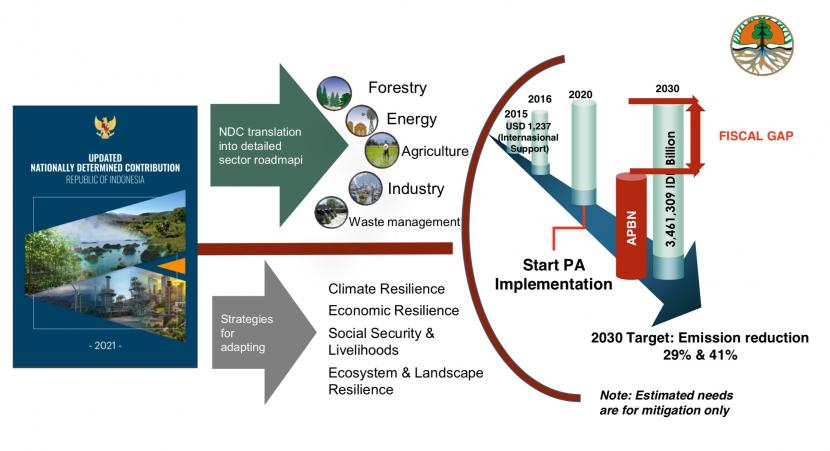REPUBLIKA.CO.ID, JAKARTA -- Funding is one of the crucial factors to achieve Indonesia’s commitment to reduce greenhouse gas (GHG) emissions. The government of Indonesia is committed to reducing GHG emissions against business-as-usual scenario by 41 percent with international support. The commitment is in line with the ratification of the Paris Agreement.
Indonesia is already leading by being on track in achieving its unconditional target of 29 percent in GHG emissions reduction, set in the Nationally Determined Contribution (NDC). NDC commitment is outlined in the NDC Implementation Strategy document, ensuring that NDC activities carried out for mitigation and adaptation sectors are well monitored and evaluated.
The implementation of Indonesia’s NDC is important to achieve the 2030 NDC targets and ensure the proper allocation and mobilization of resources as mandated by the Draft Presidential Regulation on Carbon Pricing.
Director of the Sectoral and Regional Resources Mobilization (MS2R) of KLHK, Wahyu Marjaka, said in order to achieve this commitment, funding, capacity enhancement, and technology development are crucial factors. The basis for providing resource support for climate actions is stipulated in Article 9 of the Paris Agreement. It calls developed nations to provide funding resources that may assist developing countries in their climate change mitigation and adaptation efforts.
In regard to funding, Decision 12/CMA.1 regulates the identification of funding resources available from developed countries, including the obligation to report the support provided and mobilized by these countries and the projected levels of public financial resources to be provided for developing countries. These reports are compulsory in the form of a biennial report (BR).
Moreover, Decision 13/CMA.1 outlines the need to accelerate the allocation of funds for the Adaptation Fund. Meanwhile, Decision 14/CMA.1 mandates the establishment of a collective quantified goal in the form of funding in accordance with Decision 1/CP.21.
“Although a mutual understanding regarding funding requirements and how parties convey information on funding has been established, yet as of 2021, developing countries are still pressing for a more binding agreement,” Wahyu said. It concerns the allocation of funding support for developing countries, funding support for improved reporting over time, as well as the mobilized funding commitments amounting to USD 100 billion targeted in 2020.
It is therefore essential to note that funding arrangements are an essential aspect. As stated in Article 2 of the Paris Agreement, one of the goals is to ensure a consistent financial flow to achieve a development path that is low in GHG emissions and resilient to climate change.
Within the national context, the funding needs, as well as funding received and utilized for NDC mitigation and adaptation actions, must be properly defined alongside the concrete efforts required for mobilizing existing and other funding opportunities. Presently, the government relies on several environmental funding models, including the state budget, commercial, philanthropy, public-private partnerships, blended finance, and impact investment.
Director of Center for Climate Change Financing and Multilateral Policy, Dian Lestari, said that the government has been currently mobilizing existing funding in the form of budget tagging.
“Further improvements are still needed, such as separating between the funds received from the state budget, bilateral or multilateral arrangements, as well as public interventions in the form of climate-specific activities,” she said. Other funding opportunities will need to be explored further, especially those that would involve Non-Party Stakeholders (NPS) as donors/contributors.
According to the Second Biennial Update Report (BUR-2) in 2018, Indonesia requires funding to achieve its GHG emissions reduction targets by 2030, amounting to Rp. 3,461 trillion for the period 2018-2030 (approximately Rp. 266.2 trillion per year), or equivalent to USD 247.2 billion (approximately USD 19 billion per year).
The government has also made efforts to allocate funds through climate budget tagging by tagging the budgets in line ministries and agencies for climate-related activities since 2016. For the past five years, the average budget allocated for climate change has been around Rp 95.17 trillion per year or about 4.1 percent of the yearly state budget (APBN).
From 2018 to 2030, the government has allocated and will continue to allocate funds from the state budget to finance an average of 21.3 percent from the total annual funding needs for climate mitigation, or about Rp. 266.2 trillion per year, as outlined in BUR-2.
However, in 2020, allocated funds for climate change experienced a significant reduction due to the state budget reallocations and refocusing. The allocated budget for climate change was reduced to Rp 44.51 trillion for mitigation actions (57 percent) and Rp 33.30 trillion for adaptation actions (43 percent).
The government continues pushing for the mobilization of climate funding resources outside the state budget to achieve its NDC commitments. One of many important non-state budget funding resources that could help Indonesia’s NDC activities is the Green Climate Fund. Other innovative international funding for climate-related programs is Forest Carbon Partnership Facility (FCPF), BioCarbon Fund, Ford Foundation, and funding from The World Bank.
All in all, the government has made several innovations in environmental funding instruments. One important step is improving the effectiveness of state budget through budget tagging and establishment of environmental funding performance-based criteria.
Government has also mainstreamed environmental funding in Regional Funding Mechanisms through Regional Incentive Funds (Dana Insentif Daerah/DID), Village Funds (Dana Desa/DD); utilizing bilateral/multilateral/global funding schemes such as GEF, GCF, and REDD+; and also utilizing Sustainable Financing Schemes such as Green Bond, Tropical Landscape Financial Facility (TLFF), SDG Indonesia One, PT Sarana Multi Infrastruktur (PT SMI), and Green Sukuk, among others.



